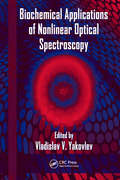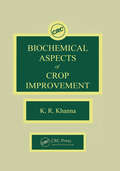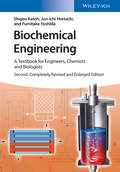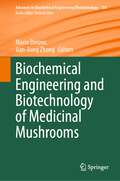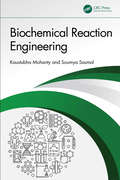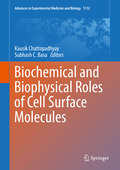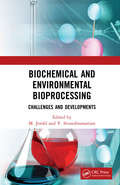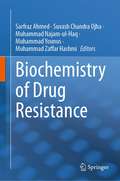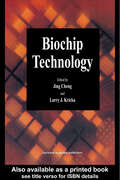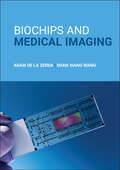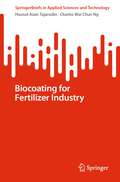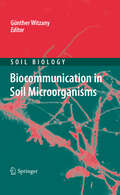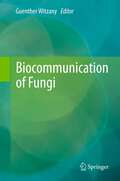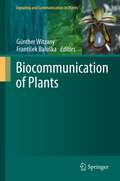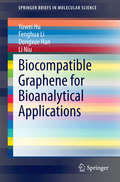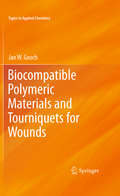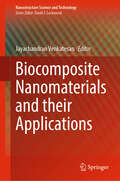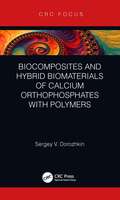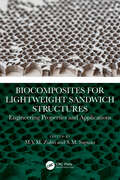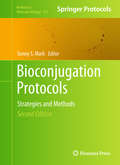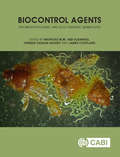- Table View
- List View
Biochemical Applications of Nonlinear Optical Spectroscopy (Optical Science and Engineering)
by Vladislav V. YakovlevFor a host of reasons, nonlinear optical spectroscopy is a valuable tool for biochemical applications where minimally invasive diagnostics is desired. Biochemical Applications of Nonlinear Optical Spectroscopy presents the latest technological advances and offers a perspective on future directions in this important field.Written by an international panel of experts, this volume begins with a comparison of nonlinear optical spectroscopy and x-ray crystallography. The text examines the use of multiphoton fluorescence to study chemical phenomena in the skin, the use of nonlinear optics to enhance traditional optical spectroscopy, and the multimodal approach, which incorporates several spectroscopic techniques in one instrument. Later chapters explore Raman microscopy, third-harmonic generation microscopy, and non-linear Raman microspectroscopy. The text explores the promise of beam shaping and the use of broadband laser pulse generated through continuum generation and an optical pulse shaper.Lastly, the book discusses the effects of spatial beam shaping on the generated nonlinear Raman signals in a tightly focused geometry and provides insight into the extension of nonlinear optical spectroscopy to the nanoscale through the use of plasmonic tip-enhanced arrangement. With novel experimental approaches to this technology expanding day-by-day, the book’s balanced coverage from a wide range of international contributors not only elucidates important achievements, but also outlines future directions in this dynamic and promising field.
Biochemical Aspects of Crop Improvement
by K. R. KhannaThis book provides a comprehensive review at the biochemical and molecular level of the processes and techniques that contribute to crop improvement. General topics include a historical perspective of the advancements in crop improvement; cultivar systematics and biochemical and molecular markers in crop improvement programs; the genetics of physiological and biochemical processes affecting crop yield; the genetics of photosynthesis, chloroplast, relevant enzymes, and mutations; osmoregulation/adjustment and the production of protective compounds in relation to drought tolerance; and the biochemistry of disease resistance, including elicitors, defense response genes, their role in the production of phytoalexins and other strategies against pathogens. Other topics include quality breeding (e.g., molecular gene structure, changing individual amino acids, enhancing nutritive value of proteins) and biotechnology/genetic engineering. Geneticists, biochemists, botanists, agricultural specialists and others involved in crop improvement and breeding should consider this volume essential reading.
Biochemical Engineering
by Shigeo Katoh Fumitake Yoshida Jun-Ichi HoriuchiCompletely revised, updated, and enlarged, this second edition now contains a subchapter on biorecognition assays, plus a chapter on bioprocess control added by the new co-author Jun-ichi Horiuchi, who is one of the leading experts in the field. The central theme of the textbook remains the application of chemical engineering principles to biological processes in general, demonstrating how a chemical engineer would address and solve problems. To create a logical and clear structure, the book is divided into three parts. The first deals with the basic concepts and principles of chemical engineering and can be read by those students with no prior knowledge of chemical engineering. The second part focuses on process aspects, such as heat and mass transfer, bioreactors, and separation methods. Finally, the third section describes practical aspects, including medical device production, downstream operations, and fermenter engineering. More than 40 exemplary solved exercises facilitate understanding of the complex engineering background, while self-study is supported by the inclusion of over 80 exercises at the end of each chapter, which are supplemented by the corresponding solutions. An excellent, comprehensive introduction to the principles of biochemical engineering.
Biochemical Engineering and Biotechnology of Medicinal Mushrooms (Advances in Biochemical Engineering/Biotechnology #184)
by Jian-Jiang Zhong Marin BerovicThis book offers a comprehensive review of the latest developments in medicinal mushroom biochemical engineering and biotechnology, and it also analyses the circular economy of mushroom bioproduction. Divided into 13 chapters, the book begins with a historical perspective of medicinal mushrooms, followed by authoritative chapters that explore the farming of medicinal mushrooms and bioeconomy, as well as the limitations of using medicinal mushrooms to produce metabolites. Subsequent chapters cover topics such as solid-state and submerged cultivation of medicinal mushroom mycelia in bioreactors, pilot and industrial bioreactor cultivation experiences, downstream processing of medicinal mushroom products, and biochemistry of medicinal mushroom bioactive compounds. Particular attention is given to the recent genetic engineering techniques applied in mushroom cultivation. The book closes with a chapter devoted to the health and clinical benefits of medicinal fungi, where readers will find expert insights into the therapeutic implications of medicinal fungi. In this book, readers will find an authoritative perspective on the past, present and future of medicinal mushrooms, and will also learn about some recent clinical studies with isolates from these natural products. Given its breadth, this book will appeal to biotechnologists working in mushroom cultivation, as well as to professionals interested in traditional pharmacy and medicine.
Biochemical Reaction Engineering
by Kaustubha Mohanty Soumya SasmalThis textbook comprehensively covers fundamental and advanced aspects of biochemical engineering along with MATLAB codes. It comprehensively covers important topics including enzyme catalyzed reaction kinetics, catalytic antibodies and non-protein biomolecules as catalysts, process flow diagram (PFD), piping & instrumentation diagram (P&ID), wastewater treatment processes, design of fermenters and mass and energy balance. Pedagogical features including solved problems and unsolved exercises are interspersed throughout the text for better understanding.This book: Provides solid foundation and understanding of the fundamental principles of mathematics, science, and engineering Explores tools for solving theoretical and open-ended biochemical engineering problems Covers principles of downstream process and biochemical engineering principles with illustration and problems Discusses application of computer and programming in biochemical engineering Covers case studies for bioprocess plant design. The textbook is primarily written for senior undergraduate and graduate students in the fields of chemical engineering, biotechnology, and food process engineering for courses on biochemical engineering/bioprocess engineering/downstream processing.
Biochemical and Biophysical Roles of Cell Surface Molecules (Advances in Experimental Medicine and Biology #1112)
by Subhash C. Basu Kausik ChattopadhyayCell surface small molecules and macromolecules, such as members of cholesterol family (including steroid hormones), the glycolipid family (sphingolipids), the glycoprotein family (both N-linked and O-linked), and a vast array of other receptors have been shown to be involved in normal and abnormal cellular processes. The 11th International Symposium on Cell Surface Macromolecules, held in Mohali, India, in February 2017 provided a comprehensive update on the major advances in this area. Presenting selected contributions from this meeting, this book comprises 24 chapters, which provide in-depth analyses of data on the role of cell surface macromolecules in cellular function and their alterations associated with pathological conditions. It includes comprehensive research papers and critical overviews of the functional role of cell surface molecules, discussing topics such as biochemical, biophysical, and cell biological approaches to study cell membrane molecules, and metabolism of glycoconjugates.
Biochemical and Environmental Bioprocessing: Challenges and Developments
by V. Sivasubramanian M. JeroldThe rapid growth of industries has resulted in the generation of high volume of solid and liquid waste. Today, there is a need of Clean and Green technology for the sustainable waste management. Biochemical and Environmental Bioprocessing: Challenges and Developments explore the State-of-art green technologies to manage the waste and to recover value added products. Microbes play an important role in the bioremediation. Bioprocess engineering an interdisciplinary connects the Science and Technology. The bioconversion and bioremediation is essentially required for the management of various hazardous substances in the environment. This book will give an intensive knowledge on the application of Biochemical and Bioprocess technologies for the eco-friendly management of pollution. This book serves as a fundamental to the students, researchers, academicians and Engineers working in the area of Environmental Bioremediation and in the exploration of various bioproducts from waste. Features Reviews various biological methods for the treatment of effluents from Industries by using biomass and biopolymers. Highlights the applications of various bioreactors like Anaerobic Sequential Batch Reactor, Continuously stirred anaerobic digester, Up-flow anaerobic sludge blanket reactor, Fluidized and expanded bed reactors. Presents the cultivation of algae in Open Pond, Closed loop System, and Photo-bioreactors for bioenergy production. Discusses the intensified and integrated biorefinery approach by Microwave Irradiation, Pyrolysis, Acoustic cavitation, Hydrodynamic cavitation, Electron beam irradiation, High pressure Autoclave reactor, Steam explosion and photochemical oxidation. Outlines the usage of microbial fuel cell (MFC) for the production bioelectricity generation in different modules Tubular MFC, Stacked MFC, Separate electrode modules Cutting edge research of synthesis of biogenic nanoparticles and Pigments by green route for the health care and environment management.
Biochemistry of Drug Resistance
by Muhammad Zaffar Hashmi Sarfraz Ahmed Suvash Chandra Ojha Muhammad Najam-ul-Haq Muhammad YounusThis book provides a comprehensive discussion on the current information and evidence on the latest developments in the field of drugs resistance. Drug resistance is the reduction in effectiveness of a medication such as an antimicrobial or an antineoplastic in treating a disease or condition. This leads to negative outcomes at great risk of public health; therefore, increasing efforts are dedicated to the development of a new generation of medications that will help deal with this phenomenon. Decades of technological innovations in drug design have demonstrated the potential of resistance. Enormous information on various aspects of antibiotics resistance is available. However, literature on drug resistance specifically related to infectious and non-infectious diseases is rarely presented, particularly those focusing on the mechanisms, biochemistry, kinetics, dynamics, and management of drug resistance. Therefore, there is an immense need for a systematic compilation on the available information about this issue. All the chapters are logically selected and arranged to provide state-of-the-art information about all aspects of drugs resistance. After an introductory chapter, four chapters are dedicated to infectious microbial diseases, whereas two other chapters are complimenting this theme and focusing on drugs resistance in ear, nose and throat, and skin diseases. The recent advances in the understanding of drugs resistance in lung, neurological, kidney, heart, and liver diseases are also covered. Biochemistry of drugs resistance in cancer, HIV, ocular, reproductive, and diabetes diseases is also discussed. Finally, a chapter dedicated to the “management of drug resistance” has been included.
Biochip Technology
by Jing Cheng Larry J. KrickaBiochip technology has experienced explosive growth in recent years and Biochip technology describes the basic manufacturing and fabrication processes and the current range of applications of these chips. Top scientists from the biochip industry and related areas explain the diverse applications of biochips in gene sequencing, expression monitoring
Biochips and Medical Imaging
by Shan Xiang Wang Adam de la ZerdaAdvanced, recent developments in biochips and medical imaging Biochips and Medical Imaging is designed as a professional resource, covering recent biochip and medical imaging developments. Within the text, the authors encourage uniting aspects of engineering, biology, and medicine to facilitate advancements in the field of molecular diagnostics and imaging. Biochips are microchips for efficiently screening biological analytes. This book aims at presenting information on the state-of-the-art and emerging biosensors, biochips, and imaging devices of the body&’s systems, including the endocrine, circulatory, and immune systems. Medical diagnostics includes biochips (in-vitro diagnostics) and medical and molecular imaging (in-vivo imaging). Biochips and Medical Imaging explores the role of in-vitro and in-vivo diagnostics. It enables an instructor to share in-depth examples of the use of biochips in diagnosing cancer and cardiovascular diseases. Provides real-life knowledge on biochips and medical imaging, written by leading researchers Serves as a resource for professionals working in the biochip or imaging fields Features an accessible approach for anyone interested in biochips and their applications Readers of Biochips and Medical Imaging can expand their knowledge of medical technology, even if they have no biological knowledge and a limited math background. With its focus on important developments, this book is sure to also capture the interest of bioengineering and biomaterials scientists, structural biologists, electrical engineers, and nanotechnologists.
Biocide Guanidine Containing Polymers: Synthesis, Structure and Properties
by SivovThis volume deals with chemistry of polyelectrolytes, namely biocide guanidine containing polymers, discussing both synthesis of new guanidine containing monomers of diallyl and acrylic nature and their structure and investigation of their radical (co)polymerization and properties of new (co)polymers.The first parts of the book describe radical pol
Bioclimatic Approaches in Urban and Building Design (PoliTO Springer Series)
by Giacomo ChiesaThis book explores the bioclimatic approach to building design. Constant innovations in the field are evident, including the need to face climate changes and increase the local resilience at different scales (regional, urban, architectural). Differently from other contributions, this book provides a definition of the bioclimatic design approach following a technological and performance-driven vision. It includes one of the largest collection of research voices on the topic, becoming also a critical reference work for bioclimatic theory. It is intended for architects, engineers, researchers, and technicians who have professional and research interests in bioclimatic and in sustainable and technological design issues.
Bioclimatic Architecture in Warm Climates: A Guide for Best Practices in Africa
by Manuel Correia Guedes Gustavo CantuariaThis book provides a comprehensive, hands-on approach to bioclimatic building design in Africa. Bioclimatic design is at the core of urban sustainability, and is a critical issue in Africa, where “imported” building typologies are being used at an increasing pace, disregarding the local context and consequently causing damage to the environment, to the economy, and to the culture itself. This book provides a concise set of sustainable design guidelines to be applied in both new buildings and the refurbishment of old buildings, and integrates bioclimatic design strategies with other sustainability issues such as: cultural aspects, affordability, and urban planning. Chapters are fully illustrated with photographs and drawings and include best-practice examples and strategies making it accessible to engineers, architects, students and a broad range of professionals in the building industry. Encompasses all climatic regions in Africa;Integrates bioclimatic design strategies with other sustainability issues;Discusses new design to refurbishment, from urban to rural, including office buildings, residential, tourism, social housing and self building.
Biocoating for Fertilizer Industry (SpringerBriefs in Applied Sciences and Technology)
by Husnul Azan Tajarudin Charles Wai NgThis book presents the advancement of coating materials technology especially in agriculture, particularly for fertilizers. Fertilizers are a critical component in meeting rising demands and ensuring global food security. A new generation of fertilizers made by coating granules with biopolymers address these issues. Coating in agriculture is an important area in research for a more sustainable future. Many examples and instances from existing research and related research gaps are discussed. It includes applications of composites as fertilizer’s coating, advantages and disadvantages of fertilizer coating from composites, applications of bacteria in composite, applications of bacteria in fertilizer industry as well as the common techniques of coating fertilizers with drying process.
Biocommunication in Soil Microorganisms (Soil Biology #23)
by Günther WitzanyCommunication is defined as an interaction between at least two living agents which share a repertoire of signs. These are combined according to syntactic, semantic and context-dependent, pragmatic rules in order to coordinate behavior. This volume deals with the important roles of soil bacteria in parasitic and symbiotic interactions with viruses, plants, animals and fungi. Starting with a general overview of the key levels of communication between bacteria, further reviews examine the various aspects of intracellular as well as intercellular biocommunication between soil microorganisms. This includes the various levels of biocommunication between phages and bacteria, between soil algae and bacteria, and between bacteria, fungi and plants in the rhizosphere, the role of plasmids and transposons, horizontal gene transfer, quorum sensing and quorum quenching, bacterial-host cohabitation, phage-mediated genetic exchange and soil viral ecology.
Biocommunication of Fungi
by Günther WitzanyFungi are sessile, highly sensitive organisms that actively compete for environmental resources both above and below the ground. They assess their surroundings, estimate how much energy they need for particular goals, and then realise the optimum variant. They take measures to control certain environmental resources. They perceive themselves and can distinguish between 'self' and 'non-self'. They process and evaluate information and then modify their behaviour accordingly. These highly diverse competences show us that this is possible owing to sign(aling)-mediated communication processes within fungal cells (intraorganismic), between the same, related and different fungal species (interorganismic), and between fungi and non-fungal organisms (transorganismic). Intraorganismic communication involves sign-mediated interactions within cells (intracellular) and between cells (intercellular). This is crucial in coordinating growth and development, shape and dynamics. Such communication must function both on the local level and between widely separated mycelium parts. This allows fungi to coordinate appropriate response behaviors in a differentiated manner to their current developmental status and physiological influences.
Biocommunication of Plants (Signaling and Communication in Plants #14)
by František Baluška Günther WitzanyPlants are sessile, highly sensitive organisms that actively compete for environmental resources both above and below the ground. They assess their surroundings, estimate how much energy they need for particular goals, and then realise the optimum variant. They take measures to control certain environmental resources. They perceive themselves and can distinguish between 'self' and 'non-self'. They process and evaluate information and then modify their behaviour accordingly. These highly diverse competences are made possible by parallel sign(alling)-mediated communication processes within the plant body (intraorganismic), between the same, related and different species (interorganismic), and between plants and non-plant organisms (transorganismic). Intraorganismic communication involves sign-mediated interactions within cells (intracellular) and between cells (intercellular). This is crucial in coordinating growth and development, shape and dynamics. Such communication must function both on the local level and between widely separated plant parts. This allows plants to coordinate appropriate response behaviours in a differentiated manner, depending on their current developmental status and physiological influences. Lastly, this volume documents how plant ecosphere inhabitants communicate with each other to coordinate their behavioural patterns, as well as the role of viruses in these highly dynamic interactional networks.
Biocompatible Graphene for Bioanalytical Applications (SpringerBriefs in Molecular Science)
by Yuwei Hu Fenghua Li Dongxue Han Li NiuThis book highlights the latest advances in the use of graphene and bio-compatible-material-decorated graphene to detect various targets (e. g. DNA, RNA, amino acids, peptides, proteins, enzymes, antigens, glucose, DA, AA, UA, ATP, NADH, gas, ions, etc. ). It focuses on the specific interaction of these substances with graphene (or modified graphene) and the efficient transduction of the target recognition event into detectable signals via various techniques. Particular emphasis is given to well-designed strategies for constructing graphene-based platforms and target determination. It also covers other bio-analytical applications including cellular imaging, drug delivery and bacteria inhibition, before turning to a discussion of future challenges and prospects of graphene in bio-analytical applications. This book is intended for researchers working in the fields of analytical chemistry, nanomaterials and biomedical engineering. Li Niu is a Professor at the State Key Laboratory of Electroanalytical Chemistry, Changchun Institute of Applied Chemistry, Chinese Academy of Sciences.
Biocompatible Polymeric Materials and Tourniquets for Wounds (Topics in Applied Chemistry)
by Jan W. GoochIn recent years biocompatible polymers for injuries and wounds have seen advances and innovations that have outpaced the growing field's literature. In this book Dr. Jan W. Gooch, a National Research Council Research Associateship Award recipient, reveals how innovative polymer technology can be applied to the common combat and trauma wounds associated with damaged soft tissue and bleeding. The scope of his investigation spans four distinct devices for wounds, liquid and particulate barrier dressings for soft tissue wounds, sutureless tissue adhesives, antibacterial nanoemulsions, one-hand operated and automatic tourniquets for the battlefield.
Biocomposite Materials: Design and Mechanical Properties Characterization (Composites Science and Technology)
by Naheed Saba Mohamed Thariq Hameed Sultan Mohd Ridzuan Mohd Jamir Mohd Shukry Abdul Majid Azwan Iskandar AzmiThe book highlights the recent research developments in biocomposite design, mechanical performance and utility. It discusses innovative experimental approaches along with mechanical designs and manufacturing aspects of various fibrous polymer matrix composites and presents examples of the synthesis and development of biocomposites and their applications. It is useful for researchers developing biocomposite materials for biomedical and environmental applications.
Biocomposite Nanomaterials and their Applications (Nanostructure Science and Technology)
by Jayachandran VenkatesanThis contributed book is focused on the use of nanomaterials in biomedical applications, particularly in the development of pharmaceuticals, nutraceuticals, and cosmeceuticals. It covers a wide range of nanomaterials, including polymers, metals, and carbon-based materials, and discusses their incorporation into polymeric biocomposites to create materials with unique properties. The book overviews the various applications of these nanocomposites, including tissue engineering, drug delivery, biosensors, and packaging. It is a useful resource for research scholars, graduate students, academics, and pharmaceutical companies working in the fields of material science and nanotechnology.
Biocomposites and Hybrid Biomaterials of Calcium Orthophosphates with Polymers
by Sergey V. DorozhkinThis title gives an overview of composites and biocomposites. It discusses the history of CaPO4/ /polymer biocomposites and hybrid biomaterials, as well as analyzing the latest developments in the field. It also covers bioactivity and biodegradation of CaPO4-based biomaterials.
Biocomposites for Lightweight Sandwich Structures: Engineering Properties and Applications
by S. M. Sapuan M.Y.M. ZuhriBiocomposites for Lightweight Sandwich Structures: Engineering Properties and Applications highlights how the relationship between biocomposites and sandwich structures can provide a unique combination of superior properties that can be optimized for environmentally friendly lightweight applications. It introduces current performance of biocomposites, sandwich structure applications, machining and manufacturing methods, energy-absorbing capabilities, and strengthening techniques of structures, as well as potential, challenges, and future perspectives on performance improvement. Provides latest research on biocomposites and use in lightweight engineering applications. Explores the suitability of core designs using biocomposites and related environmentally friendly materials. Includes recent manufacturing technologies and important performance criteria of sustainable materials for lightweight structures. Discusses existing commercial materials and those that are currently under research and development. This comprehensive reference will be of interest to materials, mechanical, and aerospace engineers and those working in related fields interested in development of materials for lightweight designs.
Bioconjugation Protocols: Strategies and Methods (Methods in Molecular Biology #751)
by Sonny S. MarkContemporary approaches to the synthesis of chemically modified biomacromolecules (proteins, nucleic acids, lipids, and carbohydrates) not only require efficient means to control conjugation and the specific site of attachment of the conjugated moiety but also the effective use of recent developments in the fields of pharmaceutical chemistry, biomolecular/polymer engineering, and nanobiotechnology. In this second edition of Bioconjugation Protocols: Strategies and Methods, expert researchers update the classic methods and introduce valuable new approaches that go beyond basic conjugation techniques to include elements from advanced organic synthesis, molecular biology, surface biotechnology, materials science, and nanobioscience/engineering. These readily reproducible methods cover the preparation of biomolecular conjugates using a variety of labeling techniques and semisynthetic approaches. Additional chapters address the biofunctionalization of surface structures, including organic/inorganic thin films, as well as various types of nanostructures (magnetic nanoparticles, quantum dots, carbon nanotubes, and silicon nanowire devices). All the protocols follow the successful Methods in Molecular BiologyTM series format, each one offering step-by-step laboratory instructions, an introduction outlining the principle behind the technique, lists of the necessary equipment and reagents, and tips on troubleshooting and avoiding known pitfalls. Cutting-edge and highly practical, Bioconjugation Protocols: Strategies and Methods, Second Edition offers both novice and experienced researchers access to the broad array of techniques needed to carry out the semisynthesis of functional biomolecular reagents and/or the biofunctionalization of surfaces and structures of unique interest for a wide variety of applications, ranging from novel biomedical diagnostics to powerful new therapeutics to advanced biomaterials.
Biocontrol Agents
by Tarique Hassan Askary Mahfouz M.M. Abd-Elgawad James CouplandThis book describes entomopathogenic and slug parasitic nematodes as potential biocontrol agents in crop insect and slug pest management. Addressing research on these two nematodes from tropical, subtropical and temperate countries, it covers the new techniques and major developments regarding mass production, formulation, application, commercialization and safety measures. Plans for future strategies to make these beneficial nematodes cost-effective and expand their use by including them in integrated pest management programmes in different agro-ecosystems are also discussed. Biocontrol Agents: Entomopathogenic and Slug Parasitic Nematodes provides a comprehensive review of the topic and is an essential resource for researchers, industry practitioners and advanced students in the fields of biological control and integrated pest management.
